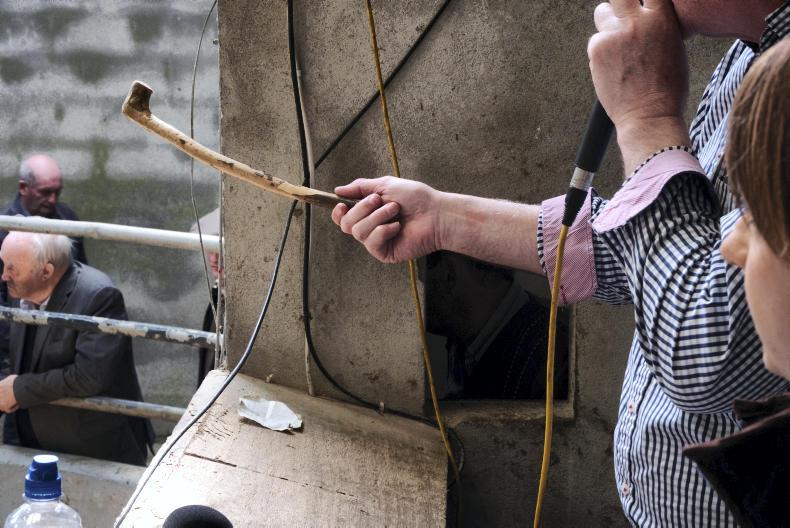The decision to close all livestock marts, while anticipated, was a massive blow to marts, farmers and all others involved in the trade.
Over the past 10 days marts up and down the country have implemented measures to halt the spread of coronavirus which included hand sanitising station, signing into marts and practising social distancing. This worked better in some marts than others.
Speaking to the Irish Farmers Journal, Ennis mart manager Martin McNamara said: “We put a huge effort in over the last two weeks in all our mart locations. I took on extra staff to help make sure we had everybody spaced out. We totally recognised the seriousness of the situation and we wanted to ensure farmers were safe while continuing to trade. It’s a massive disappointment given the work we have put in, but we have to deal with it and we will.”
The numbers
The mart closures come ahead of an extremely busy period. If we look at 2018 movements, April and May was the busiest two month period for mart movements, with 429,483 cattle moving through marts.
Looking at farm to farm movements over the same period, the figure stands at 315,473 movements.
At a conservative commission rate of €20/head that number would equate to over €10m in loss of revenue if marts stay closed for April and May.
Cashflow issues
As with any business, marts depend on cashflow to keep the wheel turning and this sudden halt to business is likely to put some smaller marts under pressure. There have been a few very big sales in recent weeks and marts would have let out some credit during this time using cash from bigger sales in April and May to balance the books.
Given the impending cashflow difficulties on farms, cheques will likely be presented quicker than usual. The current closure is likely to put some of the smaller marts under severe financial pressure in the short-term.
Purchasing conundrum
It will also cause concern for thousands of farmers who summer graze cattle each year. Keeping cattle for seven consecutive months means that herd owners are eligible for ANC payments. To be eligible farmers need to have all cattle purchased by the end of April, with the intention of selling at the beginning of November. The average stocking rate needs to be 0.15 L.U/ha for the entire farm for the full calendar year. The payment rates for this scheme range from €88-€148/ha and come to over €3,000 of an annual payment in September on many farms .
Selling
Figure 1 outlines other businesses that will also be impacted by the current closures. Farmers are the biggest losers. They are without their main avenue to sell livestock for the next few weeks. While farm-to-farm movements haven’t been locked down, selling at home is a different game and it can be hard to determine what a fair price is.
The mart ring is the fairest way to sell livestock and you are guaranteed payment, something farmers need to be careful of when selling at home over the next few weeks.
Employment
The 85 Irish mart locations provide employment to over 1,000 people and closure has meant these people have been temporarily laid off until marts reopen. Mart canteens are also closed, with staff and suppliers also hit with the mart closure.
Hauliers
Marts also create significant knock-on business. Hundreds of hauliers haul cattle to and from marts every day and their work has also dried up. While farm-to-farm movements will take up some of this slack, it won’t replace marts.
Livestock buyers and agents have also seen their work dry up at one of the busiest time of the year. Cattle agents have customers ready to buy cattle for on a fee per head basis. While these operators will likely try to buy on farm in the coming weeks, the logistics of that is a lot different to picking up 100 cattle in a mart.
Rural towns
Mart days are often the busiest days in small rural towns. Hundreds of farmers attending the mart would have traditionally complemented other business like supermarkets, vet suppliers, hardware shops, etc. whenever they were in town. This gave a lift to businesses in the town and will be missed in the coming weeks.
Social occasion
Marts are also a social occasion for many farmers. In a time when drink driving laws have almost eliminated the country pub, the mart is for some the only day in the week that they get to interact with others. This will be missed by some farmers, especially those living on their own. Members of the rural community need to be mindful of this and try and ensure that these farmers aren’t forgotten about in the coming weeks.
Marts have been in discussion with the Department of Agriculture about possible solutions to and ways around trading livestock without risking the health and safety of buyers and sellers. The hope is that some type of weighing and valuing services carried out at marts will resume. This would ensure transparency, guarantee payment and maintain a fair place for the trade of livestock in the coming months.
Read more
Marts critical in determining a fair price for cattle – ICSA
Coronavirus: IFA calls on banks to offer more flexibility
Further calls for marts to provide matchmaking service
The decision to close all livestock marts, while anticipated, was a massive blow to marts, farmers and all others involved in the trade.
Over the past 10 days marts up and down the country have implemented measures to halt the spread of coronavirus which included hand sanitising station, signing into marts and practising social distancing. This worked better in some marts than others.
Speaking to the Irish Farmers Journal, Ennis mart manager Martin McNamara said: “We put a huge effort in over the last two weeks in all our mart locations. I took on extra staff to help make sure we had everybody spaced out. We totally recognised the seriousness of the situation and we wanted to ensure farmers were safe while continuing to trade. It’s a massive disappointment given the work we have put in, but we have to deal with it and we will.”
The numbers
The mart closures come ahead of an extremely busy period. If we look at 2018 movements, April and May was the busiest two month period for mart movements, with 429,483 cattle moving through marts.
Looking at farm to farm movements over the same period, the figure stands at 315,473 movements.
At a conservative commission rate of €20/head that number would equate to over €10m in loss of revenue if marts stay closed for April and May.
Cashflow issues
As with any business, marts depend on cashflow to keep the wheel turning and this sudden halt to business is likely to put some smaller marts under pressure. There have been a few very big sales in recent weeks and marts would have let out some credit during this time using cash from bigger sales in April and May to balance the books.
Given the impending cashflow difficulties on farms, cheques will likely be presented quicker than usual. The current closure is likely to put some of the smaller marts under severe financial pressure in the short-term.
Purchasing conundrum
It will also cause concern for thousands of farmers who summer graze cattle each year. Keeping cattle for seven consecutive months means that herd owners are eligible for ANC payments. To be eligible farmers need to have all cattle purchased by the end of April, with the intention of selling at the beginning of November. The average stocking rate needs to be 0.15 L.U/ha for the entire farm for the full calendar year. The payment rates for this scheme range from €88-€148/ha and come to over €3,000 of an annual payment in September on many farms .
Selling
Figure 1 outlines other businesses that will also be impacted by the current closures. Farmers are the biggest losers. They are without their main avenue to sell livestock for the next few weeks. While farm-to-farm movements haven’t been locked down, selling at home is a different game and it can be hard to determine what a fair price is.
The mart ring is the fairest way to sell livestock and you are guaranteed payment, something farmers need to be careful of when selling at home over the next few weeks.
Employment
The 85 Irish mart locations provide employment to over 1,000 people and closure has meant these people have been temporarily laid off until marts reopen. Mart canteens are also closed, with staff and suppliers also hit with the mart closure.
Hauliers
Marts also create significant knock-on business. Hundreds of hauliers haul cattle to and from marts every day and their work has also dried up. While farm-to-farm movements will take up some of this slack, it won’t replace marts.
Livestock buyers and agents have also seen their work dry up at one of the busiest time of the year. Cattle agents have customers ready to buy cattle for on a fee per head basis. While these operators will likely try to buy on farm in the coming weeks, the logistics of that is a lot different to picking up 100 cattle in a mart.
Rural towns
Mart days are often the busiest days in small rural towns. Hundreds of farmers attending the mart would have traditionally complemented other business like supermarkets, vet suppliers, hardware shops, etc. whenever they were in town. This gave a lift to businesses in the town and will be missed in the coming weeks.
Social occasion
Marts are also a social occasion for many farmers. In a time when drink driving laws have almost eliminated the country pub, the mart is for some the only day in the week that they get to interact with others. This will be missed by some farmers, especially those living on their own. Members of the rural community need to be mindful of this and try and ensure that these farmers aren’t forgotten about in the coming weeks.
Marts have been in discussion with the Department of Agriculture about possible solutions to and ways around trading livestock without risking the health and safety of buyers and sellers. The hope is that some type of weighing and valuing services carried out at marts will resume. This would ensure transparency, guarantee payment and maintain a fair place for the trade of livestock in the coming months.
Read more
Marts critical in determining a fair price for cattle – ICSA
Coronavirus: IFA calls on banks to offer more flexibility
Further calls for marts to provide matchmaking service






 This is a subscriber-only article
This is a subscriber-only article










SHARING OPTIONS: